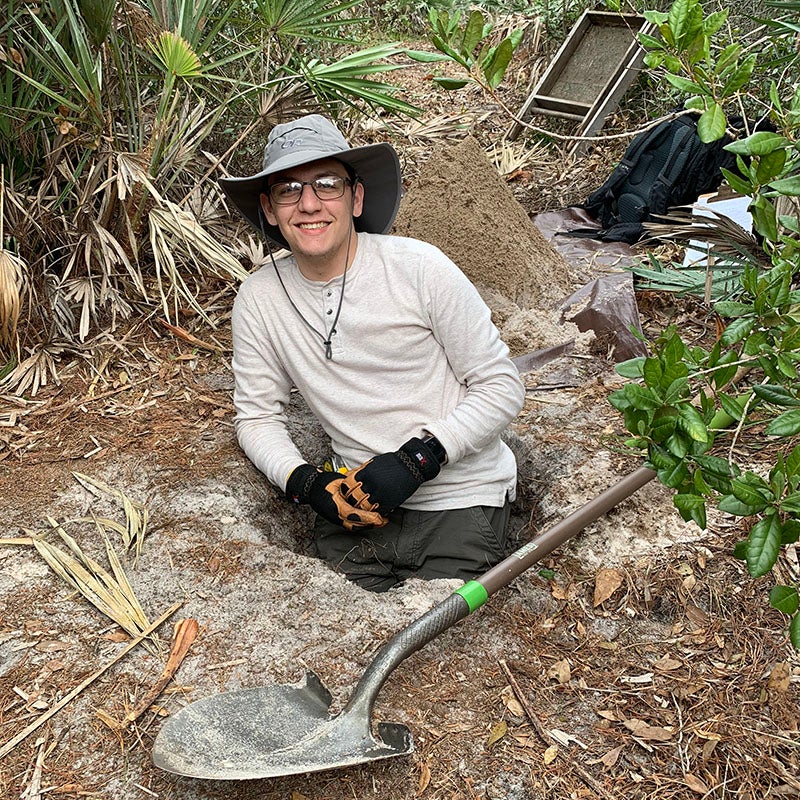Alexander Nalewaik ’21 enrolled at UCF as an undergraduate with one thing in mind. He wanted to merge his love of history, people and the outdoors into a major that would lead to a great career.
Fast forward a few years and the anthropology alum is now pursuing a master’s degree in the field while completing research that not only helps preserve history, but also integrates technology into the process. We sat down with the Fort Myers, Florida, native to chat about the research project he’ll be presenting at this year’s Student Scholar Symposium and how that’s impacting his future career path. The symposium is part of Student Research Week, which is free, open to the public and ongoing in the Student Union this week.
What does your research examine and how does it impacts the community?
My research project title is “Historical Archaeology and Multimodal Digital Technologies to Capture and Record the Past.” The research I will be presenting during Student Research Week centers on documenting America’s last remaining Civilian Conservation Corps (CCC) watermill. This local Central Florida historic site, located within the Juniper Springs Recreational area in the Ocala National Forest, is one of the first sites constructed by the Civilian Conservation Corps (a U.S. government work relief program) in the forest. Its construction was part of an early CCC experiment exploring the efficacy of federally funded tourist sites to stabilize local economies during the Great Depression and the Juniper Springs Millhouse was built to electrify the surrounding area. Today, it remains the last functioning millhouse constructed by the CCC.
This project explores the application of photogrammetry and 3D modeling tools to support traditional HABS/HAER-style documentation. The combination of these two digital recording techniques is new to the field and provides an easier way of conducting HABS/HAER-style documentation for official federal and state reports. These tools also allow for the current condition of the site to be recorded into the digital world, preserving its impact on the generations of people who have visited the site, and those in the Ocala area who benefited from the electricity it provided in the early 1930s. This project also provides data for a National Register of Historic Places (NRHP) nomination to protect the mill, justify additional funding, and support the continued operation of the mill for future generations.
How did you develop the idea for this research project?
Being a part of the UCF-USFS (United States Forest Service) archaeological field school helped me to make connections to my current master’s advisor, Dr. (Edward) González-Tennant, and Ocala National Forest archaeologists, John Dysart and Rachel Thompson. Through these connections, I was pointed at the site and, through additional term papers in my undergraduate classes, I learned the importance of preserving the site.
Why is research important to you?
This research is important due to the significance of the CCC. The CCC created around 800 national and state parks around the country, worked on hundreds of civil infrastructure projects, planted over three billion native trees and actively fought wildfires that popped up during their time. With Juniper Springs, this site was created as an experiment to test the impacts of tourism on a small depression-era town. Largely, the experiment worked, with Ocala and the nearby Astor being one of the first small towns in Central Florida to recover following the end of the Great Depression. This research created a digital model of the site, giving the public a permanent window into the architectural history of the CCC and the 1930s, while also registering the site to the NRHP helping to ensure proper preservation of the site continues for generations to come.
Why are you pursuing your major or field of study?
Throughout my undergraduate career, I took classes and was a part of key internships through the department, such as the Cape Canaveral Archaeological Mitigation Project in 2020, and the fall and summer UCF-USFS Ocala archaeological field schools in 2020 and 2021, that helped me to narrow my field of study to what it is today.
Why did you choose UCF?
I chose UCF as an undergraduate in 2018 because of how exciting the campus seemed. With so many events happening every day, the university seemed like a small city with opportunities at every turn, which helped to make me feel at home and excited for my future here. I chose UCF again in 2021 for my graduate degree because of the many connections I made from my time here as an undergraduate. Through UCF, I worked as an orientation team leader in 2019, worked for the Student Union starting in 2020, and I met and learned from so many prominent researchers in my department, so it was hard to say goodbye to the university. Also, Knightro is one cool mascot.
What’s next?
This summer I will be continuing my research in Ocala, working as a crew chief for the UCF-USFS Ocala summer field school, where we will be continuing our work at the Yearling historic archaeological site within the Ocala National Forest. I will also be continuing my work at the Juniper Springs Millhouse, working on photogrammetry and laser scanning 3D models of the structure, and the site as a whole.
What is your career goal?
My goal is to use my research and experience in the Ocala National Forest to become a USFS or National Park Service archaeologist, where I can continue protecting historic sites around the country.




